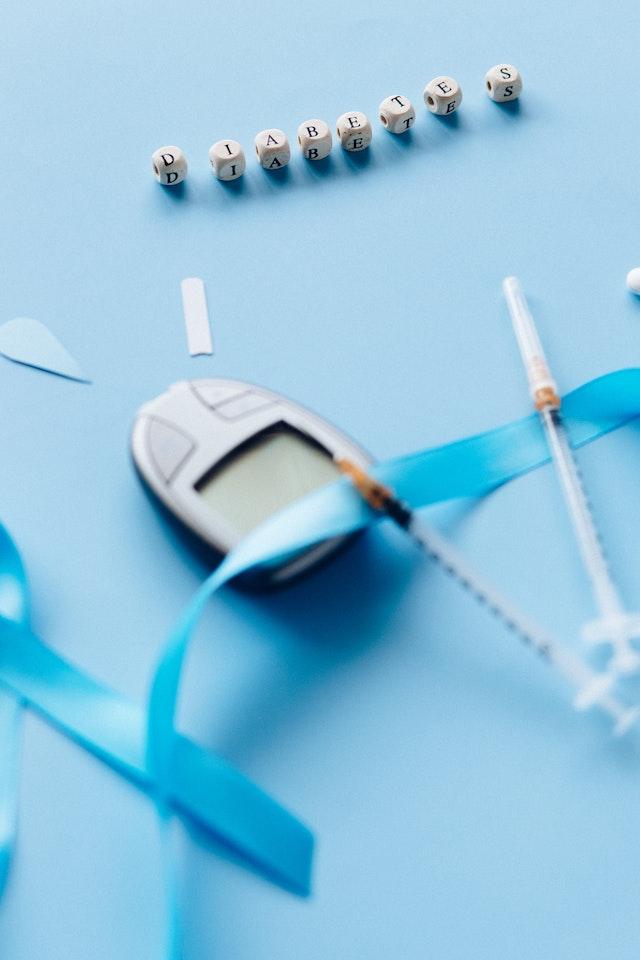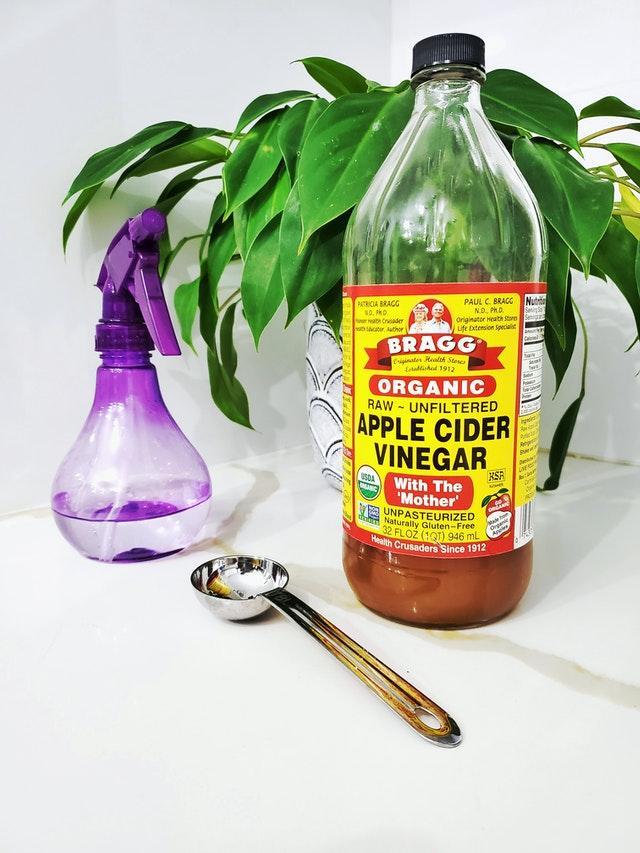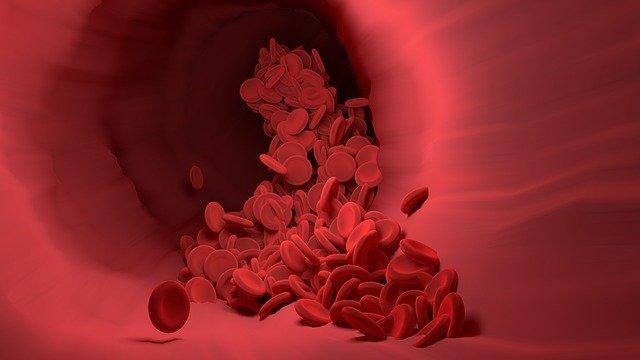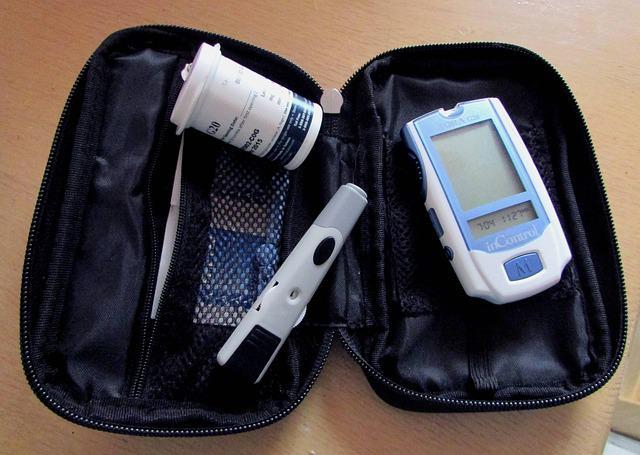Archive for August 2022

Benefits for Vitamin B12 for Diabetics
Is Vitamin B12 Good for Diabetics?
There is an essential vitamin to your body yet it cannot produce it. This essential vitamin is known as cobalamin or Vitamin B12. Apart from being added to certain foods and being available as an oral supplement or injection, you can find Vitamin B12 naturally in animal products.
There was a vitamin B12 deficiency of about 29.66% in diabetic patients as per the laboratory tests that were done in a study in 2016. There were also lower values of B12 statistically in patients on metformin.
Vitamin B12 deficiency was significantly higher in those who smoked than in those who did not smoke. Additionally, vitamin B12 was lower in patients using multivitamins compared to non-users.
Your body needs vitamin B12 for various purposes. This vitamin is essential for the formation of red blood cells and DNA synthesis apart from being essential in supporting the normal function of your nerve cells. The recommended daily intake (RDI) is 2.4 mcg, for most adults. However, for breastfeeding or expectant mothers, it is higher.

What Are the Symptoms of B12 Deficiency?
There is a wide range of symptoms that may be related to folate or vitamin B12 deficiency. If the condition goes untreated it can worsen despite it developing gradually. The symptoms include: –
• Fatigue or extreme tiredness
• Lethargy (lack of energy)
• Breathlessness
• Feeling faint
• Headaches
• Pale skin
• Palpitations (noticeable heartbeats)
Benefits Of Vitamin B12
Improving your memory, helping prevent heart disease, and boosting your energy is among the multiple impressive ways that vitamin B12 may benefit your body.
Here are 9 benefits of vitamin B12 that are all based on science:
1. Helps with red blood cells formation and anemia prevention
Red blood cells are essential to your body and vitamin B12 plays a crucial role in their production. A reduction in red blood cell formation is caused by low vitamin B12 since the low levels of vitamin B12 inhibit the proper development of red blood cells.
The deficiency of vitamin B12 in your body will lead to red blood cells becoming larger and typically oval. Small and round is an indication of healthy red blood cells.
The rate at which red blood cells will be moving into your bloodstream will not be appropriate because of their larger and irregular shape and this will cause megaloblastic anemia.
Moreover, you may experience symptoms such as weakness and fatigue when you are anemic and this is due to the lack of enough red blood cells in your body to transport oxygen to your vital organs.
2. May Prevent Major Birth Defects
A healthy pregnancy is much dependent on adequate vitamin B 12 in your body. For the proper development of a fetus’s brain and nervous system, sufficient B12 levels are required from the mother, especially during pregnancy.
You may have an increased risk of birth defects such as neural tube defects due to vitamin B12 deficiency in the beginning stages of pregnancy. Moreover, premature birth or miscarriage may be contributed by maternal vitamin B12 deficiency.
Compared to those with adequate levels, women are three times more likely to give birth to a child with birth defects should they have vitamin B12 of lower than 250 mg/dl as per results from one study.
Further, compared to women with levels above 400 mg/dl, women with a vitamin B12 deficiency and levels below 150 mg/dl the risk of giving birth to a child with defects was five times higher.
3. May Support Bone Health and Prevent Osteoporosis
Your bone health may be supported by adequate levels of vitamin b12 in your body. People with a vitamin B12 deficiency also had lower than normal bone mineral density as per the result of one study in more than 2,500 adults.
You are at an increased risk of having osteoporosis in case you have bones with decreased mineral density since your bones are likely to become fragile and delicate over time. Especially in women, there is a link between osteoporosis and low vitamin B12, and poor bone health as shown in other studies.
4. May Reduce Your Risk of Macular Degeneration
An eye disease that mainly affects your central vision is known as macular degeneration. To help prevent the risk of age-related macular degeneration maintaining adequate levels of vitamin B12 is essential.
Additionally, there is a type of amino acid that is found in your bloodstream known as homocysteine and according to studies supplementing with vitamin B12 may help lower it. An increased risk of age-related macular degeneration has been associated with elevated homocysteine levels.
Supplementing with vitamin B12, along with folic acid and vitamin B6, may reduce this risk as per a study that involved 5,000 women aged 40 and above.
To fully understand vitamin B12’s role in promoting vision health and preventing macular degeneration further studies are ultimately needed.
5. May Improve Mood and Symptoms of Depression
Your mood may be improved by using vitamin B12. It is not yet fully understood the effect of vitamin B12 on mood. However, there is a chemical responsible for regulating mood and it is known as serotonin and vitamin B12 plays an essential role in its synthesizing and metabolizing.
Therefore, you are likely to have a depressed mood because of decreased serotonin production that is caused by vitamin B12 deficiency in your body.
Symptoms of depression in people deficient in this vitamin can be improved by the use of vitamin B12 supplements as supported by studies.
Compared to those treated with antidepressants alone in one study with people with depression and low vitamin B12 levels, it was found that those who received both antidepressants and vitamin B12 were more likely to show improved depressive symptoms.
There were two times more the risk of severe depression associated with vitamin B12 deficiency as per discovery from another study. Furthermore, better treatment outcomes and an increased probability of recovery from the major depressive disorder have been linked with high vitamin B12.
Research does not currently suggest that vitamin B12 supplements have the same effect in those with normal B 12 levels despite these supplements helping to improve mood and depression in people with deficiency.
6. May Benefit Your Brain by Preventing the Loss of Neurons
Memory loss especially in adults has been associated with vitamin B12 deficiency. The loss of neurons in the brain is known as brain atrophy and often this is associated with dementia or memory loss using vitamin B12 can play a major role in preventing it.
A combination of vitamin B12 and omega-3 fatty acid supplements slowed mental decline as per the results of one study in people with early-stage dementia. Poor memory performance can be contributed even with vitamin B12 levels on the low side or normal in findings from another study.
Therefore, even in the absence of a clinically diagnosed deficiency, supplementing with this vitamin may improve memory.
To make sound conclusions on the effect of vitamin B12 supplements on memory and cognitive function, more research is needed.
7. May Give You an Energy Boost
The go-to product for a surge of energy has long been touted to be vitamin B12 supplements. Despite them not necessarily providing energy by themselves, the production of energy by your body is always supported by vitamins.
Scientific evidence suggesting that vitamin B12 supplements can boost energy in those with sufficient levels of this vitamin is currently not there. On the other hand, taking a supplement or increasing your intake will likely improve your energy level especially if you are significantly deficient in vitamin B12.
Fatigue or lack of energy is one of the most common early signs of vitamin B12 deficiency.
8. May Improve Heart Health by Decreasing Homocysteine
An increased risk of heart disease has been linked to high blood levels of the common amino acid homocysteine. Your homocysteine levels are likely to become elevated if you are significantly deficient in vitamin B12. Your risk of heart disease may be reduced by a decrease in homocysteine levels with the help of vitamin B12 as shown by the studies.
To understand the relationship between vitamin B12 and heart health, further research is needed. This is because scientific evidence to confirm vitamin B12 supplements are effective in this regard is currently not there.
9. Supports Healthy Hair, Skin and Nails
To promote healthy hair, skin, and nails, adequate levels of vitamin B12 are needed given this vitamin’s role in cell production.
It is true that various dermatologic symptoms include hyperpigmentation, nail discoloration, hair changes, vitiligo (another term for the loss of skin color in patches), and angular stomatitis (inflamed and cracked mouth corners) can be caused by low vitamin B12 levels in your body.
Dermatologic symptoms in people with vitamin B12 deficiency can be improved by supplementing with vitamin B12. However, taking a vitamin B12 supplement is unlikely to improve your skin, nail strength, or hair health if you are well-nourished and not deficient in this vitamin.
Who Is at Risk of Vitamin B12 Deficiency?
An estimated 20% of people in the United States and the United Kingdom aged 60 and above have normal or deficient borderline levels while the number of people with vitamin B12 deficiency is estimated to be around 6%.
The occurrence of vitamin B12 deficiency can happen in one of two ways. It can be either your body is unable to fully absorb vitamin B12 from the food you eat or the food and diet you take do not have adequate amounts of the vitamin.
Those at risk of vitamin B12 deficiency are as follows:
• Older adults
• If you have gastrointestinal conditions like Crohn’s disease or celiac disease.
• If you have ever had surgeries especially gastrointestinal like bariatric surgery or bowel resection surgery
• If you are on a strict vegan diet
• If you are using blood sugar control such as metformin
• If you are using proton pump inhibitors for chronic heartburn
A reduction in the absorption of vitamin B12 can be caused if there is reduced secretion of hydrochloric acid in the stomach of many older adults.
Your doctor may recommend intramuscular injections of B12 to increase your levels if your body has difficulty absorbing it.
Despite some plant-based kinds of milk or grains having been fortified with Vitamin B12, it can only be naturally found in animal products in abundance since it is always limited in vegan diets. Because of this, people with a strict vegan diet are at risk of vitamin B12 deficiency.
Preventing vitamin B12 should be easy if you eat a healthy, varied diet. However, it is advisable that you speak to your doctor especially if you think you might be at risk.
Oral or intramuscular injections are the most common ways of preventing or resolving vitamin B12 deficiency.
Metformin And Vitamin B12
The relation between prolonged usage of metformin and vitamin B12 deficiency has been shown in the evidence from observational along with interventional studies.
The calcium-dependent absorption of B12 may be affected. The dose and the duration of metformin usage have been stated to be inversely related to the serum vitamin B12 values.
Considerable problem of peripheral neuropathy in non-insulin-dependent diabetes mellitus (NIDDM) patients may increase due to the extended use of metformin, accompanied by vitamin B12 deficiency.
Vitamin B12 deficiency affects about 30% of diabetics who are 40 years of age and above and state about having a diminished sensory perception in their feet by being an impending health abnormality, neuropathy.
The Bottom Line
Through diet or supplements are the only means that you must obtain vitamin B12, a water-soluble vitamin. Preventing major birth defects, bone health, improving mood, and maintaining healthy skin and hair are some of the many bodily functions and benefits of vitamin B12 to your health.
It is crucial that you get enough vitamin B12 through your diet. However, supplements are a simple way to increase your B12 intake if you struggle to obtain enough or have a condition that affects its absorption in your body.
FAQs
- Do diabetics need B12?
For optimal hemopoietic, neuro-cognitive and cardiovascular function, vitamin B12, which is an essential micronutrient is required. Among patients with type and type 2 diabetes mellitus, biochemical and clinical vitamin B12 deficiency has been demonstrated to be highly prevalent.
- Does B12 Lower Blood Sugar?
To metabolize proteins, fat, and carbohydrates into glucose, the help of vitamin b12 is essential. Your body’s main source of energy is glucose and because of this, low glucose levels in your body can be caused by vitamin B12 deficiency. Fatigue is one of the main symptoms of hypoglycemia and to treat severe fatigue, vitamin B12 supplements are widely used.
- Does Vitamin B12 Give You Energy?
Vitamin B12 might reduce your chance of fatigue thanks to its role in energy metabolism. To convert protein, fat, and carbs into energy, your body needs the help of vitamin B12 for its metabolization.
- How Much B12 Should a Type 2 Diabetic Take?
Currently, in the US, 2.4 µg of synthetic vitamin B12 daily in either in fortified food or supplement form is the believed recommendation for adults with type 2 diabetes that are 50 years and above.
- Does B12 increase diabetes?
Homocysteine levels can be reduced with B12 supplementation. With vitamin B12 therapy as there is the correction of hyperhomocysteinemia, improvement in glycaemic control can be shown in type 2 diabetes as a metabolic syndrome.
- Does B12 Help with Insulin Resistance?
In patients with metabolic syndrome, the was improved insulin resistance and endothelial dysfunction, along with decreasing homocysteine levels after folate and vitamin B12 treatment as per the results of a study. This, therefore, indicates that on cardiovascular risk factors there are multiple beneficial effects of using folic acid.
- Is Vitamin B12 Good for Diabetic Neuropathy?
When it comes to the treatment of diabetic neuropathy, it is still unclear whether taking vitamin B12 can help. A lessening pain and other abnormal sensations have been shown in some small studies. However, taking B12 supplements for diabetic neuropathy has not been shown to help people who do not have a vitamin B12 deficiency.
- Are B12 shots Good for Diabetics?
In reducing the risk of low B12 and HHcy-related symptoms, treatment with B12 injections or supplements would help. The pain and suffering of diabetic patients would be reduced by such practice. Besides, the medical cost associated with treatments of diabetic co-morbidities would significantly decrease.
- Which Vegetable Has the Most Vitamin B12?
Spinach, beetroot, potatoes, mushrooms, alfalfa, and many more are some of the vitamin B12 foods for vegetarians that contain a high amounts of Vitamin B12. However, some amount of vitamin B12 can be found in most vegetables.
- Does B12 Help You Sleep?
To help induce sleep, it has been found that vitamin works directly on the brain. Additionally, to help patients with sleep disorders like insomnia, vitamin B12 benefits have been demonstrated. Insomnia is a disorder for those with difficulty falling asleep. Depending on the dose that is used, vitamin B12 has also been shown to improve sleep in healthy persons.
- Does B12 Cause Weight Gain?
There is little evidence to suggest that vitamin B12 has any influence on weight loss and gain despite the various processes in which it has been involved.
- How Does B12 Make You Feel?
2.4 micrograms of vitamin B12 a day is recommended by doctors for adults since they are usually safe. Your body will pass the rest out through your pee should you take more than what you need. Vomiting, nausea, anxiety, headache, and dizziness are some of the side effects that you may experience after taking vitamin B12 in high doses.
- Can Vitamin B12 Affect Blood Pressure?
Lower systolic and diastolic blood pressure was associated with a higher intake of vitamin B12 as it was found. In children, lower systolic blood pressure was associated with a higher intake of folic acid.
- Is Vitamin B12 Good for Kidneys?
Foods that are a rich source of B vitamins are recommended by medical experts. To prevent other diseases that might cause harm to people suffering from kidney failure, vitamin B12 or folic acid and vitamin B6 along with EPO and iron function together. Therefore, it is true that when it comes to kidney function, vitamin B12 is involved.
- How Much B12 Should a Diabetic on Metformin Take?
A dosage of 2.4 mcg a day is recommended for all individuals of 14 years and above. However, a slightly more dosage will be needed for nursing or expecting women. For those taking metformin, mandatory supplementation with B12 has now been proposed. Vitamin B12 will do the trick by taking a daily multivitamin containing 100% of the daily value (DV).
- Should I Take B12 In the Morning or At Night?
Taking your B vitamins in the morning or with a meal is a general rule of thumb. For example, you should definitely take vitamin B12 in the morning. If taken at night, your sleep may be interrupted since B12 is important for energy metabolism.
- How Long Does It Take for B12 To Start Working?
Before your vitamin B12 levels and symptoms like lack of energy and extreme tiredness start to improve, it may take a few weeks. The cyanocobalamin tablets may start to work within a few days if you have a hydroxocobalamin injection to boost your vitamin B12 at the start of treatment.
- Which Vitamin Is Best for Nerves?
Energy to function for your nerves is provided by vitamin B1(thiamine) while to transmit nerve impulses correctly and relieve nerve pain, vitamin B6 is essential. To protect your nerves from damage and regenerate them vitamin B12 is involved. Your nerve pain may be partly caused by a deficiency in vitamins B12 or B1.
- Can Vitamin B12 Affect Your Eyes?
For neurological function, an essential vitamin is vitamin B12, also known as cobalamin. Progressive, bilateral, painless vision loss that is often associated with reduced color vision and central or cecocentral scotomas is a result of a rare complication caused by vitamin B12 deficiency optic neuropathy.

Benefits of a Cold Shower for Diabetics
Benefits of a Cold Shower for Diabetics – A great majority of people usually crave and enjoy hot showers in the waking hours of the morning. In fact, the feeling of the warm water on your skin is usually nothing short of magical.
As such, many folks do crank up the handle all the way up just to experience that warm caressing and massage-like feeling after a long night’s sleep.
Nonetheless, did you know that cold showers are just as important and as such should often be in your daily shower routine? More so for those with diabetes.
Many individuals often dread cold showers, especially in the mornings. However, have you ever realized that after taking one, you often feel quite different? If you have not, then you should give it a try as you might quite like the feeling afterward.
Experts indicate that you should often give cold showers a fair chance in your routine even if you do not like them. This is because, just like hot showers, they are also often associated with a number of health benefits.
Benefits of taking a cold shower
Cold showers are great and as such, some of the proven health benefits associated include:
Calming itchy skin
Cold showers have been associated with reducing the urge to scratch itchy skin. As such, even those with skin conditions that itch may overcome the desire to scratch the associated skin surfaces after taking a cold shower.
Waking up an individual
This is essentially increasing the overall alertness of an individual after a long night’s sleep. The cold shower sprays shock the body and associated organs thereby improving body activity through increased;
- Oxygen intake
- Heart rate
- Brain activity
Increasing blood circulation
This is among the top reasons cold showers are widely recommended. As the cold water contacts your skin, surface blood vessels are often constricted, and as such surface circulation is immensely reduced.
This results in faster blood circulation within the deeper vessels in the body tissues in order to counteract the cold and maintain an ideal body temperature.
In essence, cold showers often trigger the circulatory system reducing inflammation and even further preventing cardiovascular diseases. It thus has direct opposite implications compared with hot showers among individuals with hypertension or cardiovascular disease.
Reducing muscle soreness post engaging activity/exercise
Cold water often has regenerative abilities. As such, after a vigorous and engaging activity like an intense workout session, the cold shower would initiate muscle relaxation and eventual repair.
Potentially boosting weight loss
This is another scientifically proven fact given that some fat cells such as the brown fat cells can often generate body heat by burning body fat. Nonetheless, the initiation of the entire process often depends on exposing the body to cold conditions like taking a cold shower.
Encouraging glowing hair and skin
Based on several accounts of anecdotal evidence collected over the years, cold showers have often been associated with several positive implications with regard to skin glow and healthy hair.
For instance:
- Wellness experts have often claimed that since cold water constricts surface blood flow, the subsequent effect is always smooth and healthy glowing skin.
- Furthermore, cold water unlike hot water does not dry out the sebum layer of the skin. As such, your skin and hair remain lubricated, protected, and healthily glowing.
- Finally, experts also claim that cold water closes and strengthens your hair cuticles. As result, an individual’s hair may become stronger and healthier over time.
The cons of taking a cold shower
Despite the numerous benefits, cold showers also often present with some disadvantages, especially in selective scenarios. For instance;
- Cold showers are often not recommended when you are already cold.
This is because exposing your body to even colder water will not help warm you up as this will only make you even colder increasing the time your body takes to warm back up.
- Cold showers may also be a bad idea for the sick.
The cold water may create an even colder environment which might be too hard on your immune system further compromising your health. As such, it is only best to ease into the cooler temperatures rather than dive into a cold one.
Benefits of hot showers
With all the benefits of cold showers, it then begs the question of why many people like hot showers. That’s simple, many people do so to ease the stress of the day.
Thus:
A hot shower will help you relax and fall asleep better at night.
It achieves this by activating our parasympathetic nervous system which subsequently initiates the feeling of tiredness which then makes us relax and fall asleep.
Other benefits of a hot shower include:
Providing relief from cold/respiratory symptoms
Hot showers often create a warm environment which then prompts the formation of steam within the bathroom. Steam has long been used as a natural remedy for reducing cold and respiratory-associated complications.
As such, the heat from the hot water and formed steam helps to:
- Open airways
- Loosen up phlegm
- Clear out nasal passages
Aiding with blemishes
Hot water contacting the skin often facilitates the opening up of skin pores which subsequently allows your body to get rid of trapped dirt and excess oil causing blemishes thus rendering your skin smooth and with little to no blemishes.
Muscle relaxation
Finally, hot showers have also been found to help in the relief of body tension thus helping in the soothing of muscle fatigue.
The cons of a hot shower
Hot showers often do have some downsides too. However, these can often be avoided by appropriately regulating the shower water temperature and maybe taking care of your skin after a hot shower. Some of these cons include;
Drying out and irritating the skin
Hot water can often cause damage to the keratin cells on the outermost surface of the skin, the epidermis. This essentially diminishes the cells’ ability to lock in moisture thus creating dry skin.
Worsening of certain skin conditions
Since the hot water may result in dry skin, certain skin conditions like eczema may often take a turn for the worse complicating an individual’s health.
Encouraging itching
The heat from the hot shower water may often facilitate the release of histamine to the skin by mast cells resulting in initiation and continued itching and probable scratching on the skin.
Worsening of hypertension/cardiovascular disease
Individuals with these underlying health conditions may often increase their severity by taking too hot showers.
Which is better? Cold or Hot Showers?
Both shower options present with significant benefits and as such, opting for a single option might mean missing out on the other’s health benefits to your body. As such, an age-old technique is often recommended to ensure you get maximum health benefits from both options if possible.
Contrast shower
This technique entails getting the water as cold as possible and then standing in it for about a minute.
After the minute is over, you change the water temperature to as hot as your body can handle and then again stand in it for an additional one minute.
Subsequently, alternate between one minute each of cold and hot water for about three to five cycles for optimal benefits.
The cold water constricts surface blood vessels directing all the blood to the middle of the body.
Subsequently, the hot water expands the surface blood vessels allowing the blood to come rushing out again to the surface. This essentially facilitates the pumping of blood completely through the muscles, organs, and tissues of the entire body.
The contrast shower technique thus aids in rapid regeneration and detoxification of an individual’s body.
Conclusion
Despite the fear of taking cold showers, it is usually ideal to ease into the habit, slowly. You should thus start by slightly lowering the water temperature at the end of your usual shower. Make the water just cold enough that you start to feel slight discomfort and stay underneath for two to three minutes.
The next time you shower, ensure the water is slightly colder than the last time, and also try lasting underneath for an additional minute or two.
To decrease the discomfort in your mind, try deep breathing exercises when showering. After a couple of tries, let’s say seven to ten times, you might even start enjoying the cold showers and eventually turn down hot water completely.
Frequently Asked Questions (FAQs)

Why is a cold shower good for you?
A number of studies have associated cold icy showers with a heightened immune system and increased resistance to illnesses.
An example is a study in the Netherlands that concluded that cold showers reduced the number of workers calling off work for sickness by 29% and another one also connected cold showers to increased cancer survival.
Is it good to take a cold shower every day?
Taking cold showers every day has been associated with a number of benefits such as increased efficiency in the circulatory system, and better-looking skin among others. As such, it is recommended if possible.
When is the best time to have a cold shower?
The best and most recommended time is usually in the morning as it will kick-start your overall systems getting you ready for the day’s engagements. Although it might be difficult, you can often start with your limbs, submerging one at a time to ease into the coldness.
How long should a cold shower last?
This often depends entirely on an individual. Most people often prefer starting with a warm shower and then switching near the end for a brief moment of 30 seconds to about 2 minutes. Nevertheless, some also just prefer a purely brief shower of 5 to 10 minutes or as long as you need.
Do cold showers burn fat?
Yes, but the process is not going to be any faster to elicit significant changes. As such, you should focus on other fat-burning techniques like intense exercise.
Similarly, adopting cold showers to the extreme like taking a 10-minute ice bath may elicit some benefits but not significant as this may often come with complications like impaired muscle growth and strength gains.
Are cold showers unhealthy?
Definitely no. if anything, they are tremendously good for you as they have proven to elicit tremendous benefits such as improved mood, burning of fat, and increased immunity among others.
How do you shower with neuropathy?
If your nerves are dulled, telling whether the water in your shower is the right temperature or even scalding hot may be difficult.
As such, you may need to often test with your elbow, install a bath thermometer or even acquire a temperature-controlled faucet to help gauge the water temperature for safe showering.
Should you put your head under a cold shower?
While the cold water rushing on your head might be beneficial waking your brain faster and initiating all the little energy systems in the body, I would recommend taking it easy and may be doing so only in intervals of short periods or when needed. This is because it is important not to lose heat in your head as this might prompt negative implications.
Are cold showers at night good?
Despite the overwhelming recommendation for cold showers as morning activities to help with refreshment and energy boost for the rest of the day’s engagements, they also help in the night as they tend to increase an individual’s endorphins which are the feel-good hormones.
Can you sleep after a cold shower?
Yes, the cool water usually aids in tricking your whole system into sleep mode. This is because, when you sleep, your body temperature lowers and by taking a cold shower before bed, you will essentially be initiating the temperature-lowering process thus showing the body it is near bedtime.
Why should you avoid hot showers?
Hot showers are often associated with several downsides if not taken accordingly. For instance, they can inflame the skin causing redness, itching, and even peeling mimicking the side effects of a sunburn.
Furthermore, they can disrupt the skin’s natural moisture balance and retention by depriving it of the natural oils, fats, and proteins that keep it healthy and glowing.

Can Apple Cider Vinegar Lower Blood Sugar Immediately?
A significant improvement in blood glucose levels was noticed 30 minutes after consumption of apple cider vinegar by a group that used it on a short-term basis.
Over the years, folk medicine has favored apple cider medicine. Additionally, there have been multiple claims made by persons using it for its supposed advantages.
Apples are chopped, covered with water, and left at room temperature until the natural gas ferments and turn into ethanol to produce apple cider vinegar.
Bacteria then transform this alcohol into acetic acid. In the cider, “mother” strands will start to form.
These are frequently the subject of health claims and are strained out of certain products but not others. The following batch of cider can also be made using the “mother,” if desired.
Apple Cider Vinegar Nutritional Value
Apple cider vinegar does not have a significant quantity of vitamins, minerals, or even calories if you look at the nutritional fact label.
This is because the potential health benefits of apple cider vinegar are found in substances that do not form part of the standard nutritional label.
The acetic acid which forms during fermentation is apple cider vinegar’s claim to fame. There are multiple health benefits to acetic acid.
Raw apple cider also contains the following:
• Natural probiotics (friendly bacteria). This will help boost your immune system and gut health.
• Antioxidants. It will help in preventing any damage to your body’s cells.
But will apple cider vinegar really help you control blood sugar?

There is proof that fermented foods, including apple cider vinegar that contains lactic or acetic acid, can lower blood sugar levels by assisting the liver in storing glucose.
As a result, the body produces and absorbs glucose at a slower rate.
You should dilute 1 – 2 tablespoons of apple vinegar cider in a glass of water if you wish to consume it.
If you want the best and the greatest impact on your blood sugar, you should drink it just before bedtime or before meals.
Apple cider vinegar can cause stomach irritation or damage your tooth enamel. Therefore, you should not consume undiluted apple cider vinegar just like with most kinds of vinegar.
Cider made from apples is another useful cooking component. Therefore, you can use apple cider vinegar in multiple items such as salad dressings, marinades, sauces, and soups. Besides, multiple types of fish and meat work well with apple cider vinegar.
The distilled kinds of apple cider vinegar are the ones that people are most likely to see for sale. This variety of apple cider vinegar is colorless and transparent.
Side Effects of Apple Cider Vinegar
Despite apple cider vinegar having multiple benefits to your health, there are certain side effects that may come along especially if you do not use it correctly.
Some of the side effects of apple cider vinegar include:
• When your tooth enamel erodes you can never get it back. Apple cider vinegar is high in acidity. The acidity of the apple vinegar cider is likely to erode your enamel.
• If you drink apple cider vinegar straight it can easily damage your esophagus.
Watering down the apple cider vinegar is a great way of reducing its acidity and preventing problems such as enamel erosion and damage to your esophagus.
You can water down your apple cider vinegar by adding a tablespoon to a mug of warm water.
Other possible side effects of apple cider vinegar include the following:
• Lower potassium levels. Hypokalemia is a condition caused by low potassium levels. If you have low potassium levels in your body, it is advisable for you not to use it since it may worsen your condition.
• Interaction with medicines. Some medicines, such as diuretics and insulin, can interact with apple cider (water pills). Therefore, it is advisable that you ask your doctor if it is safe for you to use apple cider vinegar if are taking any medications.
• Nausea and vomiting. Some folks can’t stand apple cider vinegar’s taste or acidity, very literally. Therefore, you should stop using apple cider vinegar if it makes you feel sick.
Availability
Additionally, you can get apple cider vinegar as pills or gummies. There is no recommended dosage, so read the product’s instructions carefully or ask your doctor how much is safe for you. Look for a company that has received a third-party endorsement.
Takeaway
You may want to consider consuming diluted apple cider vinegar if you have type 2 diabetes since scientists believe it is safe to drink.
Additionally, drinking apple cider vinegar may be beneficial to your body when it comes to helping you control your blood sugar levels.
However, scientific evidence supporting the use of apple cider vinegar helps in controlling blood sugar levels is little. Therefore, using apple cider vinegar or any other isolated dietary change to be a quick fix for diabetes should not be considered.
Some of the most effective methods of controlling diabetes that you can use include eating a high-fiber diet containing the correct amount of carbohydrates, protein, and healthful fat. You should also do physical exercise regularly.
Is apple cider vinegar better than other types for blood sugar control?
Apple cider vinegar is the type of vinegar that has been studied by scientists most often for reducing blood glucose levels. However, it is believed that other types of vinegar have the potential to act similarly in the body according to researchers.
All vinegar contains acetic acid, which is the element that scientists think has an impact on managing blood sugar, cholesterol, and weight.
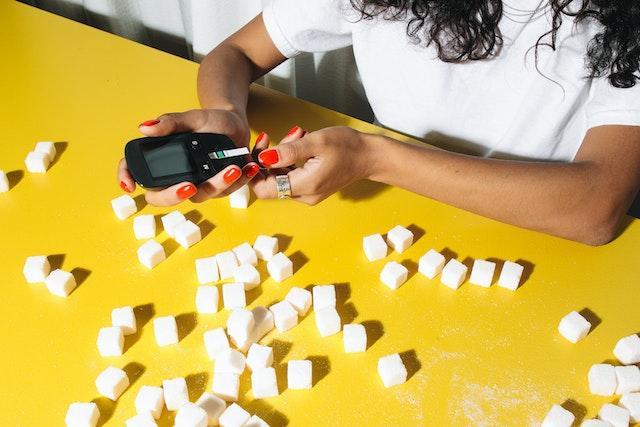
Without mentioning apple cider vinegar specifically, some research employs vinegar solutions. For example, one study showed that a 30 milliliter(ml) vinegar solution that contained 6 percent acetic acid had positive effects on glucose and lipid metabolism.
Based on acetic acid concentrations and the impact of that specific component on blood sugar, vinegar should help improve these levels theoretically.
The majority of food vinegar variants have an acetic acid content of 4–7%. To verify the advantages and outcomes of various kinds of vinegar, scientists must do additional investigation.
FAQ:
Does vinegar lower blood sugar quickly?
The rate at which your stomach empties the food you have eaten into the small intestine is slowed down by the acetic acid in vinegar.
This in turn provides the body more time to eliminate glucose from circulation and inhibits the breakdown of carbohydrates. In the end, this lessens the regular blood sugar increase following a meal.
How much apple cider vinegar do I take to lower my blood sugar?
It is interesting to note that only a tiny amount of apple cider vinegar is required to produce these results.
It has been demonstrated that taking four tablespoons (20 ml) of apple cider vinegar before meals dramatically lowers blood sugar levels after meals.
Does taking apple cider vinegar before bed lower blood sugar?
The best times to drink apple cider vinegar for blood sugar control are shortly before meals and right before bed.
For instance, consuming 2 tablespoons (30ml) of apple cider vinegar at bedtime for two days lowered fasting blood sugar levels by as much as 6% in a study of persons with type 2 diabetes.
Should I drink apple cider vinegar before or after my meal?
Consuming apple cider vinegar on an empty stomach is the best way to take it. Vinegar might lose some of its potency when you eat certain foods and drinking vinegar before meals help your body metabolize food more quickly.
Waiting for at least 20 minutes after consuming the apple cider vinegar before eating anything is recommended by experts.
How much apple cider vinegar should you drink a day for diabetes?
You should drink around two (2) spoons every day. Never drink it straight; always dilute it with water, seltzer, or tea, or include it in your food. Consume no more than 2 tablespoons daily.
What happens when you drink apple cider vinegar every day?
Lower blood triglycerides, smaller waist circumference, reduced belly fat, and weight loss are some of the results of consuming apple cider vinegar every day according to a study published in Bioscience, Biotechnology, and Biochemistry.
What is the best time to take apple cider vinegar for diabetes?
Takin 20 grams (20 ml) of apple cider vinegar diluted in 40ml of water, with 1 teaspoon of saccharine, could lower your blood sugar after meals according to research from 2004.
Additionally, taking apple cider vinegar before bed helped moderate blood sugar upon waking accordioning to another study from 2007.
How can I stabilize my blood sugar overnight?
Checking your blood sugar (or CGM) before is a great way of stabilizing your blood sugar overnight. Additionally, eating lots of food close to bedtime should be avoided.
Low-carb, early dinners without any after-dinner snacks are crucial for many diabetics to stay in range overnight. To cover your evening meal, you could choose to eat less at night and increase your basal insulin intake.
How long should I wait to eat after taking apple cider vinegar?
Yes. You can drink diluted apple cider vinegar on an empty stomach. In fact, it is the recommended way to take apple cider vinegar. Just wait about 20 minutes or so after drinking apple cider vinegar to eat.
Can apple cider vinegar damage your kidneys?
Your kidneys shouldn’t be harmed by apple cider vinegar.
What medications can you take with apple cider vinegar?
A few drugs and apple cider vinegar may not interact well.
Some medicines for diabetes. Those who consume vinegar while taking insulin-stimulating drugs run the risk of having dangerously low potassium or blood sugar levels.
Digoxin (Lanoxin). Your blood potassium levels drop when you take this drug.
Certain diuretic drugs.
Does apple cider vinegar interfere with blood pressure medication?
Continue taking any prescription drugs, and adhere to any suggested schedules. More research is required, but apple cider vinegar may help decrease blood pressure. However, it doesn’t seem that using apple cider vinegar moderately carries any hazards.
When should you not take apple cider vinegar?
If you have a sluggish stomach, you should avoid drinking apple cider vinegar.
Additionally, drinking ACV can affect the muscles of your stomach if your digestive system is slow.
Limiting the intake of apple cider vinegar to one teaspoon a day mixed with water or sprinkled on the salad is advisable in such cases or you should avoid it completely.
Caution:
To maintain healthy blood sugar levels, do not use apple cider vinegar by yourself. Maintain a healthy diet and exercise routine to treat or prevent diabetes.
Before increasing your intake of any type of vinegar you should talk to your doctor if you are currently taking blood-sugar-lowering medications.

Does MSG Affect Diabetes?
What is MSG?
MSG is a short form of monosodium glutamate. Intake of MSG in healthy adults has been linked with type 2 diabetes, obesity, and metabolic syndrome.
This is because, regardless of energy intake, intake of MSG in healthy adults correlates with the resulting increase in body mass index.
It is a flavor-improving substance made from L-glutamic acid, which occurs naturally in many meals.
Because l-glutamic acid is a non-essential amino acid, your body can make it on its own and does not require food to provide it. MSG is a common food additive that is a white, odorless crystalline powder.
It is referred to as E621 in the food business. With little effort, it dissolves in water and separates into sodium and free glutamate.
It is created by fermenting sugary ingredients including molasses, sugar cane, and sugar beet.
Your body cannot differentiate the difference between glutamic acid found naturally in some foods and that found in MSG since there is no chemical difference between them.
Unami, a distinct flavor associated with MSG, is the fifth basic flavor after sweet, sour, salty, and bitter. The flavor of Unami is described as “meaty,” alluding to the presence of proteins in food.
Inosine 5’-monophosphate (IMP) and guanosine 5’-monophosphate (GMP) as other Unami compounds apart from MSG. MSG is widely utilized in processed foods in the West and is popular in Asian cuisine.
People’s typical daily intake is thought to range between 0.3 and 1.0 grams. MSG is typically consumed in processed and packaged foods in Western nations, but it is frequently added to home cooking in China.
650,000 tons of MSG are used globally every year according to estimates. Increased risk of insulin, diabetes, and obesity has been found to be brought by intake of MSG in studies done in rodents.
The association between MSG intake and the risk of hyperglycemia after five years was assessed by researchers in the Jiangsu Nutrition Study (JIN) study that was based on a large population-based in China.
A total of 1056 people (445 men and 611 women) with fasting plasma glucose of 7.0 mmol/l (FPG>126 mg/dl) or having known diabetes and hyperglycemia as FPG>5.6 mmol/l (FPG>100.9 mg/dl) were involved in the Jiangsu Nutrition Study (JIN).
Each household was asked about their usual monthly consumption of these items to determine the amount of MSG and other seasonings consumed by individuals.
The quantity of MSG consumed per person was determined by dividing the total amount of MSG consumed by the number of people living in the household by the number of people in each household.
This figure was then adjusted for the proportion of each person’s energy intake and consumption. Also evaluated in 1056 participants was the consumption of alcohol and cigarette smoking.
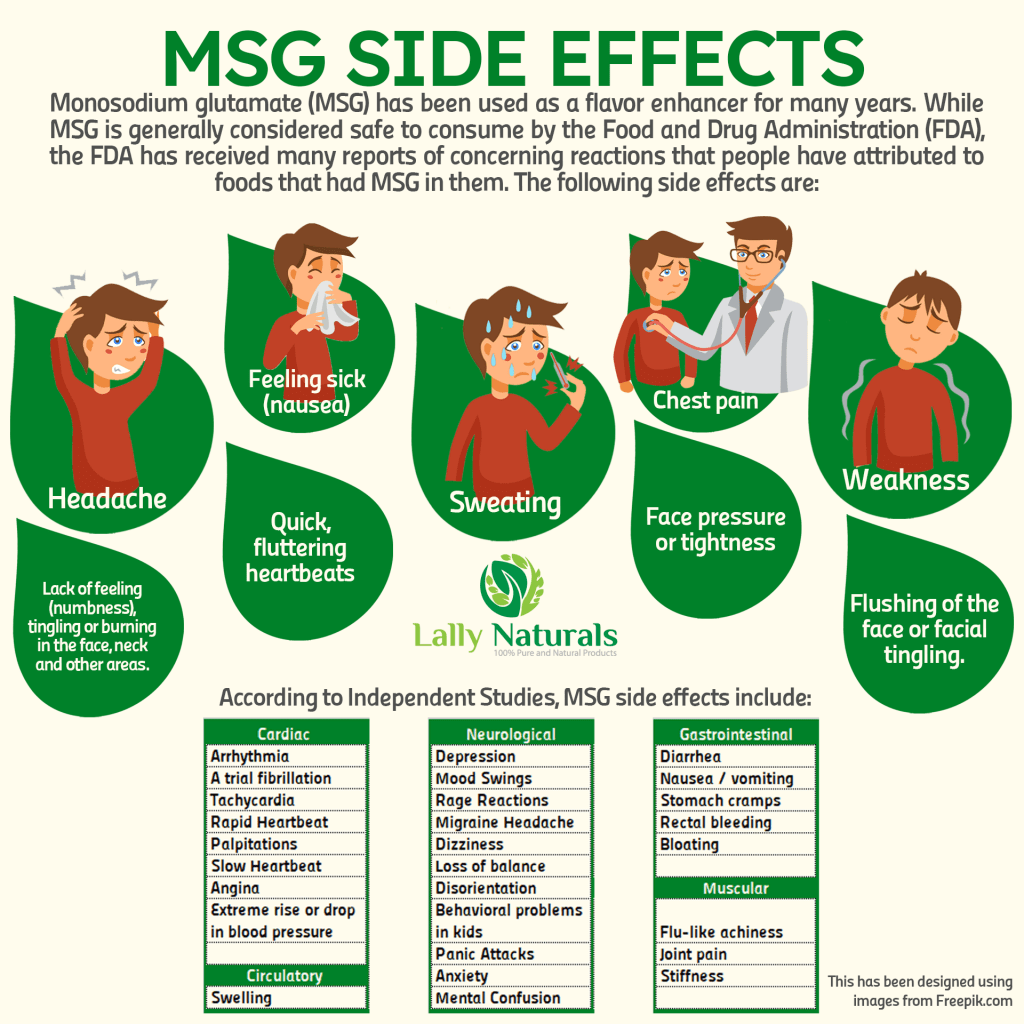
It was found by the authors that the mean intake for the entire population that participated in the research was 3.8 g/day.
Even after adjustment for a number of covariates, including dietary patterns, it was found that the highest quartile of MSG intake was associated with a lower risk of incident hyperglycemia.
Based on the findings of this study, the authors came to the conclusion that Chinese individuals who consume a lot of MSG have a lower chance of developing hyperglycemia.
To establish the casual links between MSG intake and hyperglycemia, more research is needed.
For many years, MSG has been used as a food additive. The FDA has received multiple reports of concerning reactions that people have attributed to foods that had MSG in them during this time.
The concerning reactions were known as MSG symptom complex and they included the following:
• Headache
• Flushing
• Sweating
• Face pressure or tightness
• Numbness (lack of feeling), tingling or burning in the face, neck, and other areas
• Quick fluttering heartbeats
• Chest pain
• Nausea or feeling sick
• Weakness
Common foods that contain MSG
Many different foods especially those that are high in protein contain MSG present naturally. Additionally, during processing, MSG is added to ingredients and other foods.
These are some of the common foods that you may be eating daily that contain MSG:
• Animal-based protein: chicken, beef, salmon, mackerel, scallops, crab, shrimp
• Cheese: Parmesan, Emmenthal, cheddar, Roquefort
• Vegetables: tomatoes, onions, cabbage, green peas, spinach, mushroom, broccoli
• Processed meats: pepperoni, bacon, pastrami, sausages, salami
• Sauces and dressings: soy sauce, ketchup, mustard, mayonnaise, barbecue sauce, salad dressing
• Premade and packaged foods: canned soups, canned tuna, frozen meals, crackers, potato chips, flavored snacks
• Condiments: seasoning blends, rubs
Further, to season menu items like fried chicken, chicken nuggets, and fries, fast-food chains such as McDonald’s, Chic-fill-A, and KFC use MSG.
1. Does MSG spike insulin?
Fasting healthy subjects given monosodium glutamate orally has been shown to raise plasma insulin levels without changing blood glucose levels.
2. What is MSG made of?
MSG stands for Monosodium Glutamate and it is consisting of water, sodium, and glutamate. An amino acid used to make proteins in food and our body is known as glutamate. There is no distinct flavor associated with MSG.
3. Does MSG spike blood pressure?
A significant increase in SBP and DBP was associated with MSG intake. SBP and DBP were more likely to rise in women who consumed a lot of MSG. Consumption of total glutamate was likewise positively correlated with a rise in SBP.
4. Does Chinese Food Spike Blood Sugar?
In diabetes, Chinese foods are considered one of the worst foods to consume. This is because they are high in calories, sodium, fat, and carbohydrates that can dramatically increase your blood sugar levels.
5. Is MSG Worse Than Salt?
Reaching for MSG to flavor your food can help you eat less sodium since it contains two-thirds less the amount of sodium compared to table salt. Therefore, it is a great option if you are looking to lower your sodium intake.
6. Is MSG Harmful?
MSG has been classified as a food ingredient that is generally recognized as safe by the U.S. Food and Drug Administration (FDA), although many health advocates do not agree with this assessment.
7. Does MSG Cause Inflammation?
MSG – Monosodium glutamate, which is frequently found in Asian cuisine, especially dishes made with soy sauce, can cause inflammation. Additionally, canned soups, salad dressings, and several fast foods frequently include it.
8. Does MSG Affect Cholesterol?
The results of the current study also showed that oral administration of MSG considerably increased the levels of serum LDL and VLDL cholesterol in the treatment groups. Additionally, a notable decline in HDL level was seen.
9. Is Ajinomoto Same As MSG?
Basically, Ajinomoto and MSG are the same things. MSG is the brand name of the product, and Ajinomoto is the name of the Japanese manufacturer.
The brand name Ajinomoto itself became rather well-known for the product, so the business copyrighted it to ensure exclusivity.
10. Why Is Ajinomoto Harmful?
It may cause a number of problems, including tingling and burning in the face and neck. The MSG in question is a neurotransmitter that activates the nerves and throws the neurotransmitter equilibrium.
Ajinomoto has a connection to these conditions, which can include illnesses like Alzheimer’s, Parkinson’s, and Huntington’s.
11. How Do You Avoid MSG?
The only sure way of avoiding prepacked food products is by making everything from unprocessed ingredients since MSG is pretty much in them.
Additionally, rather than dining out or purchasing frozen meals, cook your food. Rather than processed, canned or vacuum packed, buy your ingredients in the raw.
12. What Should a Diabetic Eat at A Chinese Restaurant?
You should focus on dishes packed full of lean proteins and vegetables with limited rice and noodles when ordering Chinese. An example might be steamed chicken and broccoli with the sauce on the side.
13. How Long Does MSG Stay in Your System?
Symptoms brought on by MSG are normally mild and disappear completely on their own within 72 hours.
However, you should speak to your healthcare provider, if your symptoms do not appear to resolve or continue worsening after 48 hours as it may be something more serious.
14. What Does MSG Do in Your Stomach?
A number of acid-dependent disorders may have their pathophysiology associated with the stimulating impact of MSG on the basal secretion of hydrochloric acid in the stomach.
MSG overuse can result in “Chinese Restaurant Syndrome,” gastritis, and duodenal and stomach ulcers.
15. Does MSG Affect Your Joints?
Other goods that include MSG, such as flavored canned potato chips, canned soups, soup mixes, salad dressings, and other processed sauces, are mostly unknown to the majority of people.
MSG contributes to persistent inflammation and makes age- and injury-related joint pain worse.
16. What Does MSG Do to The Brain?
MSG causes havoc on brain processes as well as the death of brain cells when it enters the brain.
Even in tiny amounts, MSG can produce reactions in many people within 48 hours, which might make it challenging to identify the exact dish that caused the reaction.
17. Does MSG Make You Gain Weight?
People who eat more MSG are more likely to be overweight or obese according to the researchers’ results.
And the risk was not just elevated because people were overindulging in MSG-rich meals. Even after taking into consideration the total quantity of calories people consumed, the association between high MSG consumption and being overweight persisted.
18. How Can You Tell If Food Has MSG In It?
In the ingredient list on the label of the majority of packaged foods, food makers must indicate when MSG is included, either by name or by its addictive code number 621. For instance, MSG might be identified as a Flavor enhancer (MSG).
19. How Much MSG Is Too Much?
While there is conflicting evidence regarding how MSG may affect general health, it is obvious that taking excessive amounts of the flavoring—3 grams or more daily—is likely to have negative side effects, such as headache and raised blood pressure.
20. How Do You Flush Out MSG?
Numerous glasses of water may lessen the severity of your symptoms and assist in flushing the MSG from your body.
Conclusion
The body of research on MSG’s impact on diabetes is unclear and has significant gaps. It’s possible that eating MSG will have negative effects.
The majority of these effects are noticeable at oral doses greater than 2000 mg/kg as well as at lower levels via gavage or injection. Lower oral doses, however, did not offer convincing proof.
Given the diversity of type 2 diabetes, MSG may be one of the many environmental factors that contribute to the condition.

5 Diabetes Dessert Recipes
Having diabetes should not restrict you from enjoying sweet treats. Some recipes are ideal for people with all types of diabetes, including pre-diabetes, diabetes type 1, diabetes type 2, and gestational diabetes.
Ideally, diabetes desserts should have one or more of the following things compared to traditional desserts:
• More fiber
• Less sugars
• Increased proteins
• More plant-based fats
If you have diabetes and you want to lower your sugar level, here are dessert recipes you should try:
5 Diabetes Dessert Recipes
1. Strawberries & Whipped Cream

The dessert is rich in antioxidants making it a good choice for diabetic people looking to boost their immune system. The ingredients include strawberries, powdered stevia, and heavy whipping cream.
Ingredients:
- Heavy Whipping Cream (1/2 cup)
- Strawberries (1/2 pound)
- Powdered Stevia (1 tablespoon)
The process of making strawberries and whipped cream is straightforward. Just slice up the strawberries and sprinkle some stevia to taste.
Add the heavy whipped cream and if you want to add some taste, consider adding milk or coconut milk.
2. Chocolate Chip Cookie Dough Bites
Egg-free no-bake cookie dough bites are perfect for you and your family. Have you ever heard of garbanzo beans?
It is a secret ingredient that makes the cookie dough bites delicious and nutritious.
Garbanzo beans are rich in proteins and fiber, which helps in lowering blood sugar levels. Although not everyone likes sugary foods, you can add maple syrup to sweeten the cookies.
Remember, if you want to balance blood sugar, almond flour is the best.
Ingredients:
- 1 1/4 cups oats
- 1 cup almond flour
- 1 can low sodium garbanzo beans rinsed and drained
- 2 tsp vanilla extract
- 1/4 tsp salt
- 1/2 tsp cinnamon
- 1/3 cup maple syrup
- 1/2 cup chocolate chips
Follow these steps to make no-bake cookie dough bites:
It’s best to mix oats and almond flour in a food processor until a fine powder is visible.
Add the rest of the ingredients except the chocolate chips. Process the ingredients until you form a batter.
If the mixture is too dry, consider adding some water. Adding some water makes the process easier.
Transfer the mixture to a bowl and stir the chocolate chips by hand. Use a cookie scoop to roll the dough into balls, then refrigerate them for about 4 hours.
Refrigeration is crucial to make the chocolate chip cookie dough bites fluffy and round without baking them.
To make mini chocolate chips:
Start the process by preheating the oven to 350°F.
Add ½ tablespoonful baking powder, flaxseed egg, or an ordinary egg to the original ingredients.
Follow the steps discussed above besides the refrigeration step.
It is advisable to skip the refrigeration step because you will eventually bake the mini chocolate chips. After transferring the mixture into a bowl, stir the chocolate chips by hand. Remember, unlike the no-bake chocolate chip cookies, mini chocolate chips should not be eaten raw because we added an egg.
Therefore, the final step entails baking the cookies for about ten minutes. When ready, the edges will start turning golden brown. Remove the cookies from the oven and transfer them to a cooling rack.
If you store the cookies in an airtight container, they can last up to a week. However, if you freeze them, they can stay fresh for up to three months.
3. Vegan Cherry Chocolate Coconut Milk Chia Pudding
You need the following ingredients:
• Coconut milk (1 1/2 cups) or any other type of milk (to keep the dessert vegan, almond milk chia pudding or coconut milk chia pudding is the best)
• Chia seeds (A little more than 1/4 cup) are antioxidants and rich in calcium, iron, proteins, and omega-3 fatty acids.
• Cacao powder (1/4 cup)
• Powdered monk fruit sweetener (2-3 Tablespoons)
• Cherries (1/4 cup, pitted and sliced)
• Heavy whipping cream (1/4 cup)
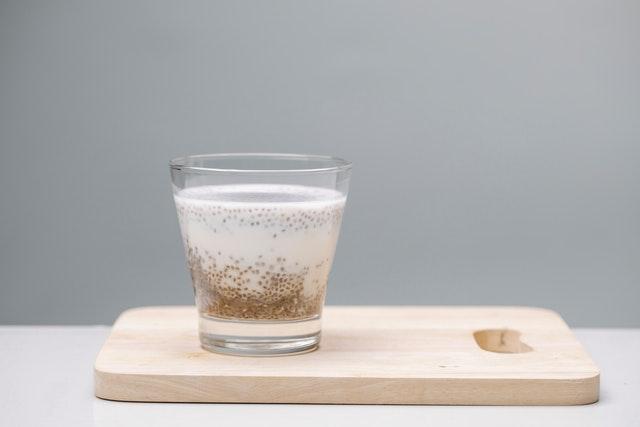
The process of making makes cherry chocolate coconut milk chia pudding is very simple. Gather, clean, and mix all the ingredients in a bowl or mug. Leave the ingredients for 4 to 5 hours to gel and firm up.
It is advisable to make the chia pudding overnight to allow the chia seeds enough time to gel and firm up.
4. Lemon Mini Cheesecake
Making this no-bake lemon mini cheesecake is easy and fast.
Typically, it would be best to make a crust first, then fill and mold the no-bake cheesecake.
However, you need a high-powered blender or food processor to prepare these delicacies successfully. So, how do you do it?

Start by adding coconut flour and oats to a blender or food processor. Blend the mixture for a few minutes until you form a fine white powder.
Add the remaining ingredients, i.e., vanilla extract, almond extract, lemon zest, cream cheese, and maple syrup. Continue processing until the ingredients become smooth.
Scoop the batter into a container, sprinkle the bites, and add coconut or lemon zest to taste. To harden the cheesecakes, refrigerate them for 2 to 4 hours.
5. Gluten Free Pumpkin Cookies
This is another no bake recipe.
Pumpkin is very nutritious, thus making it an important ingredient when making gluten-free pumpkin cookies. The no-bake gluten-free pumpkin cookies need a wet base for a start. Nut butter, maple syrup, or pumpkin puree are ideal choices. You need the following equipment:
• Bowl
• Whisk
• Spatula or rubber spoon
• Microwave
• Fork
• Storage container
Here’s the ingredient list:
- 1 cup nut butter (Almond butter is slightly healthier than peanut butter)
- ½ cup maple syrup
- 1 cup pumpkin puree
- 1 tsp vanilla extract
- 1 1/4 cup coconut flour
- 1 tbsp cinnamon
For a start, mix the maple syrup, vanilla extract, and pumpkin puree in a bowl. Whisk the ingredients until they mix thoroughly.
If the almond butter is too thick, consider microwaving it before mixing.
The next step entails adding coconut flour and cinnamon and mixing them using a spatula or spoon.
Ensure the mixture is thick to form balls. Consider adding more flour if the dough is too thin.
Form the balls and use your hand or fork to make the balls round (shaping).
If you freeze the cookies in an airtight container, they can stay fresh for up to 3 months. Remember to thaw them before eating.
Conclusion
Although diabetic people fear desserts, that should not be the case. However, you should steer clear of desserts with high sugar and carbohydrates.
Eating healthy foods is highly recommended, especially if you have a health condition. Therefore, consider seeking professional advice and researching to determine what you should and shouldn’t eat. If you are not sure about anything, do not take risks.
Instead, consult your dietician to know if you are making a mistake.
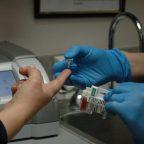
Estimate Your A1C Using Your Continuous Glucose Monitoring System
Even though A1C has been the gold standard in diabetes care, there is a huge limitation that this type of measurement possesses.
One of the most critical is the fact that A1C test results are considered to be an average only.
Unlike the latest studies that compare the A1C tests with the GMI (Glucose Management Indicator), GMI provides diabetic patients with an estimated level based on a continuous source of monitoring.
As a result of these averages, an individual may spend a huge amount of their time with both low and high sugar levels. Yet, still, be on target (i.e.what’s expected for most people with diabetes) with an A1C of under 7%.
Limitations of A1C
Based on these findings, it is important to note that A1C measurements are not considered to be perfect. Even though there has been quite a bit of effort in the past to reach perfection in its accuracy, these tests are still accurate within a margin of error of about 0.4 % points.
For example, these results may equate to an A1C that ranges from about 6.4% to 7.2%. Typically, for anyone who wears a CMG (Continous Glucose Monitoring System), the GMI is primarily seen as an estimate of their A1C.
Without using data from drawing blood, 14 days of data is needed to calculate the GMI. The GMI, in this case, uses an average of the person’s glucose reading to provide an estimate of their A1C.
TIR, TBR, and TAB are 3 other ways to manage glucose levels. For instance, these measurements are as follows:
- TIR (Time in Range): Glucose Levels range from 70 to 180 mg/dl
- TBR(Time below Range: Glucose Levels range below 70 mg/dl
- TBR(Time above Range: Glucose Levels range over 180 mg/dl
These measurements can be very useful in determining if a patient is actually meeting their glucose targets or if they need to be adjusted with another course of action. For instance, based on the numbers provided above, in general, an A1C of 7% or less equates to a TIR of 70% or higher.
Differences Between GMI and A1C
It normally takes about 2 to 3 months for new red blood cells to form. This is also the timeframe that A1C turnover is based on.
This is one of the primary reasons why an A1C level is only taken on a quarterly basis. The GMI, on the other hand, can be checked on a more frequent basis. This is primarily due to the fact that this indicator is based on a CGM date instead.
How Accurate is the GMI?
The answer to this question usually varies based on a number of different factors. Because the A1C on the CGM report is affected by the following information:
- Red blood cell turnover may be falsely skewed due to medical illnesses and diseases like anemia, sickle cell, genetic conditions, and other things that can affect the hemoglobin
- Chronic conditions like kidney diseases may show a false low in average A1C levels
- Blacks, Asians, and Hispanics (i.e. People of color) usually see higher levels of their A1C
- Indigenous individuals
All of these continuous glucose monitoring system factors must be taken into account before these numbers are considered to be accurate.
Real World Analysis of Glucose Monitoring System
Even though both of these measurements are being used in the real world, there is still little real data that compares both of these measurements for their comparable accuracy.
Lately, however, the University of Washington looked at the differences between A1C and how it compares to the GMI and its accuracy. The study from the University of Washington was able to identify the following data.
Between the years 2012 and 2019, 641 people with diabetes were used in a study to compare the results documented in A1C within a 30-day window before or after their healthcare visits.
This CGM report was uploaded and the information was as follows:
- The data on the CGM report had to encompass at least 14 days of information with 95% data sufficiency or more.
- The accuracy of the data was dependent upon the completion of the information supplied
The profile of the study group was as follows:
- 46 years of age was the average age of the study group
- Female population 52%
- Caucasian 93%
- Type 1 Diabetes – 91%
The Dexcom G5 was the most commonly used (i.e. calibrated 2 times daily).
However, there were other devices also used in this study, including the following:
- Dexcom G6
- Freestyle Libre
- Medtronic Enlife
- Medtronic Guardian
The CGM report was also based on the following averages:
- 24.5 days
- A1C of 7.3%.
- Mean CGM glucose equated to 162 mg/dl
Findings in the Study
The findings in this study were surprising, particularly since the discrepancies were much higher than those that were observed in previous trials. There was a huge difference between GMI and A1C.
For instance, according to this report, the researchers found the following:
- Patients with type 1 diabetes were reported as having a.17 percentage points fewer difference between A1C and GMI in comparison to patients who had type 2 diabetes.
- A .19 percent point greater difference was reported between GMI and A1C, in specific for patients who had a reduction in kidney function.
- No discrepancies were found in any specific device
Study’s Limitations
It is also important to note that the results of this study had their limitations.
Some of the most notable include:
- The population was not controlled and did not take into account outside factors (i.e. changes in meds)
- CGM dates were not parallel
- Accuracy of devices
- The quality of the Calibrations vary
Applications to the Real World
In the real world, the GMI may be able to predict what future A1C may be. However, you cannot expect a perfect match. Yet, both results could be somewhat close based on a .5 percentage. Also, during COV19, a large number of health care centers relied on GMI for their results.
It is also important to remember that both of these measurements are seen as estimated averages. Therefore, everyone needs to see each of these forms of measurement in the best context possible.
For instance, you should not be disappointed in cases where you do not reach your target. Your primary focus may need to be on the TIR (Time in Range). This is especially true if you need the extra encouragement to keep going in a positive way.
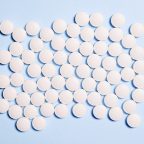
Can You Lose Weight with Metformin?
Diabetes is one of the conditions that affect most people globally. Luckily, there is medication for this condition.
The most common diabetes medication that can also improve diabetes management, according to research, is Metformin. According to research, it has been found that certain people might lose weight by using Metformin.
If you have type 2 diabetes, one of the first treatment options considered to help you manage glucose levels in your body is Metformin. There is research that suggests that Metformin may likely lead to a modest weight reduction despite it being not a weight loss drug.
Metformin and Weight Loss
People with diabetes were treated with Metformin, and they lost up to 8 kgs (around 18 lbs.) of their weight due to calorie intake, according to a small, 24-week study that was conducted in 1998.
Additionally, it was found that after using Metformin, over 4,000 people with type 2 diabetes experienced up to 2.5 kilograms (around 5.3 lbs.) weight loss for over four years when a much larger trial took place.
You are likely to lose a low amount of weight when using Metformin weight loss medication. Further, it was found that around 29% of people lost 5% or more of their body weight, and only 8% lost approximately 10% after using Metformin for weight loss.
There are various ways that using Metformin weight loss medication might have an impact on your weight. Reducing your appetite is one of the ways that Metformin for weight loss medication works.
Hormones such as Leptin and insulin have a significant role to play in your appetite. Using Metformin increases your body’s sensitivity to these hormones. Leptin is essential to your appetite since it is responsible for letting your body know when it is full and stop eating.
When your body increases its sensitivity to this hormone, you may feel less hungry.
Further, the hormone responsible for suppressing appetite is known as GLP-1. Using Metformin may increase the secretion of this hormone in your body which then suppresses your appetite and then leads to you losing weight in the process.
Semaglutide (Wegovy), a GLP-1 receptor agonist drug that precisely targets this hormone, has received FDA approval to treat both obesity and type 2 diabetes.
Reducing the amount of visceral fat in your liver and muscle tissue is another way of metformin weight loss. The abdominal cavity, which houses your liver, stomach, and intestines, among other internal organs, is where visceral fat is deposited.
It can also accumulate in muscles, including the muscle in your heart. Because visceral fat is linked to a higher risk of a number of healthy illnesses like heart disease, it is seen as being more harmful than subcutaneous fat.
Side Effects of Metformin
Generally, Metformin is considered safe. However, there are certain side effects that come along when using this medication.
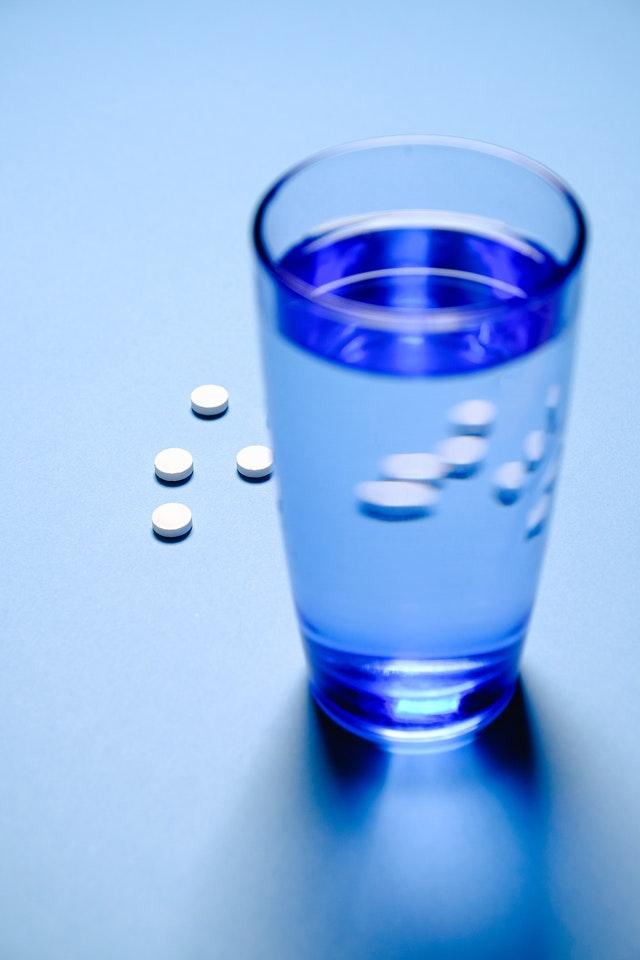
Some of the common side effects include vomiting, nausea and diarrhea. You can eat less food if you are experiencing unpleasant side effects. Consuming less food is a modest way of weight loss.
Off-bale use of Metformin for weight loss
The FDA has not approved the use of Metformin as a stand-alone therapy for weight reduction. This is because the weight loss effects of Metformin are inconsistent.
However, if doctors believe Metformin could be helpful, they may still prescribe it off-label. There are prediabetes patients with a high risk for metabolic complications, and off-label metformin use is more common.
Best ways to lose weight
Although it significantly lowers blood glucose, the generic drug metformin is not a weight loss aid. Despite this, maintaining a healthy weight is still crucial to managing your diabetes and lowering your risk of complications while also enhancing your general health and wellbeing.
FAQ about Metformin and Weight loss
1. Why does Metformin make you lose weight?
Metformin works by lowering the amount of visceral fat in your liver and muscle tissue to reduce your weight. Several of your body organs, such as the liver, stomach and intestines, are found in the abdominal cavity, where visceral fat is stored. It can also accumulate in muscles, including the muscle in your heart.
2. Can you lose belly fat with Metformin?
Despite Metformin having a beneficial effect on lipids, it has no clinically significant effect in reducing visceral fat mass. This trail gives credibility to the emerging data that Metformin is not a weight loss medicine.
3. How quickly do you lose weight on Metformin?
Metformin is not a quick fix despite studies showing that it may help with weight loss. When using Metformin, you will lose weight gradually, with the results starting to show after a year or two according to one-long-term sturdy. The amount of weight lost while using Metformin varies from one person to another.
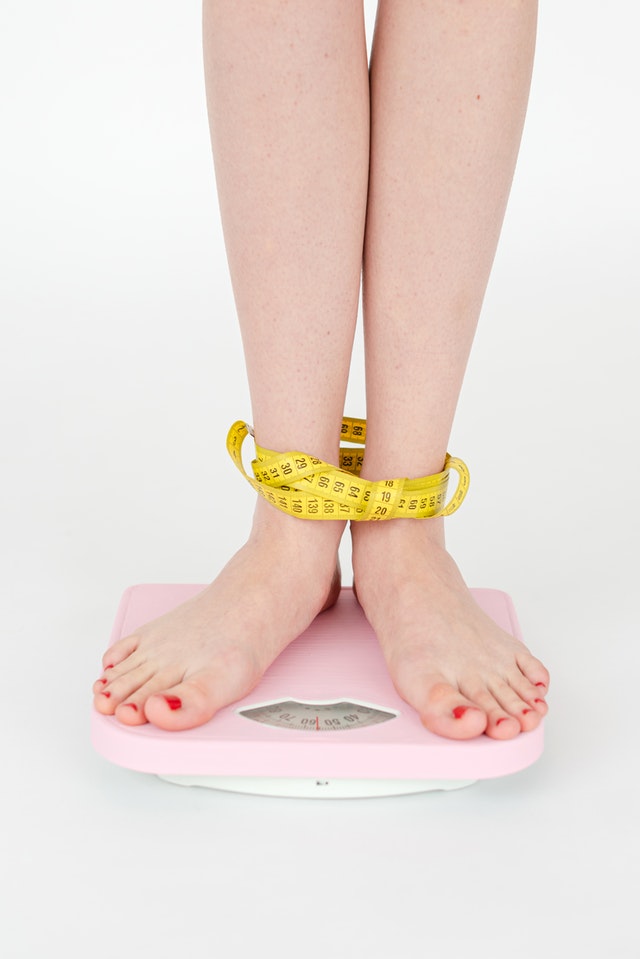
4. How do I know Metformin is working?
Your blood sugar levels will not reduce instantly when using Metformin. However, after taking Metformin, the effects can be noticeable within 48 hours. You will have clear signs that Metformin after using it for 4 to 5 days.
5. Does Metformin speed up metabolism?
The decline in fasting RQ suggests that fat was the primary energy source used during this time. Animal studies demonstrated that the administration of Metformin resulted in a decrease in body fat independent of its anorexigenic effects, which is consistent with energy metabolism results.
6. How long can you stay on Metformin?
Some patients with prediabetes are recommended to use Metformin by the American Diabetes Association. You will be on Metformin for the long term if it is prescribed for you.
Unless you experience changes that require you to stop using it or complications to your health, the long-term duration could take even decades.
7. Can a non-diabetic take Metformin to lose weight?
There is mounting evidence that Metformin may help obese non-diabetic people lose weight (6,33). According to a systematic review, orlistat and Metformin both effectively lower the BMI of overweight or obese women with polycystic ovary syndrome (PCOS)
8. Does Metformin make you poop?
It is not clear which mechanism metformin uses in lowering blood sugar concentration. However, it was found that Metformin promotes the excretion of sugar into the stool according to the bioimaging study on humans.
9. Does coffee affect Metformin?
Coffee contains caffeine. Metformin works by reducing how fast how your body breaks down caffeine. Therefore, caffeine in coffee might have increased effects and side effects when you take it with Metformin.
10. Should you drink a lot of water when taking Metformin?
In order to help reduce stomach or bowel side effects that may occur during the first few weeks of treatment, it is recommended that you take Metformin with water. It would be best if you drank a full glass of water while swallowing the tablet or extended-release tablet.
11. Is Metformin best taken at night or in the morning?
It is best to take Metformin at bedtime instead of supper time if you are taking it as Glucophage retard to improve diabetes control by reducing morning hyperglycemia.
12. Do I need to check blood sugar while taking Metformin?
When taking oral medications like Glucophage (Metformin), home testing is not typically necessary. Every three to six months, doctors generally request a blood test called a hemoglobin A1C test in place of testing.
13. How long does 500mg of Metformin last?
After taking Metformin (Glucophage), it will stay in your system for up to 96.8 hours or around four days. The half-life elimination of Metformin is around 17.6 hours.
14. What is the most common side effect of Metformin?
There are side effects that you may experience when using Metformin for the first time. Some of the side effects that you may have are nausea, vomiting and diarrhea. With time, these side effects disappear. You can take Metformin with a meal to reduce the side effects.

Diabetic Feet Swollen?
Are your diabetic feet swollen?
You are at an increased risk of developing serious diabetic foot issues if you have either type 1 or 2 diabetes and high blood sugar levels.
Diabetic foot care is critical, and it is up to you to deal with your situation. Every year, up to 100,000 adults undergo diabetes-related lower limb amputations in the USA alone.
Luckily, there is a way to help you avoid developing severe diabetic foot problems. Following the proper diabetic foot care routine is an excellent way that can help you stay away from foot complications.
Additionally, the best way you can prevent foot problems is by keeping your blood sugars in range and ensuring your HbA1c is below 7%.
Further, you can considerably help reduce the risk of diabetic foot issues by wearing recommended footwear for diabetes and neuropathy, getting your early diabetic foot exams, and following a flawless diabetic foot care routine.
Why Is Diabetic Foot Care Important?
You are at a higher risk of developing severe foot issues than the general population if you have diabetes.
Two main complications are likely to arise should you not manage your diabetes properly. The two main complications are diabetic peripheral neuropathy (DPN) which damages the nerves in your feet, and peripheral artery disease (PAD), which impedes proper blood circulation in your lower limbs.
Diabetic foot care can considerably prevent these two main complications that may lead to you having severe foot issues.
Diabetes damages the nerves in the feet
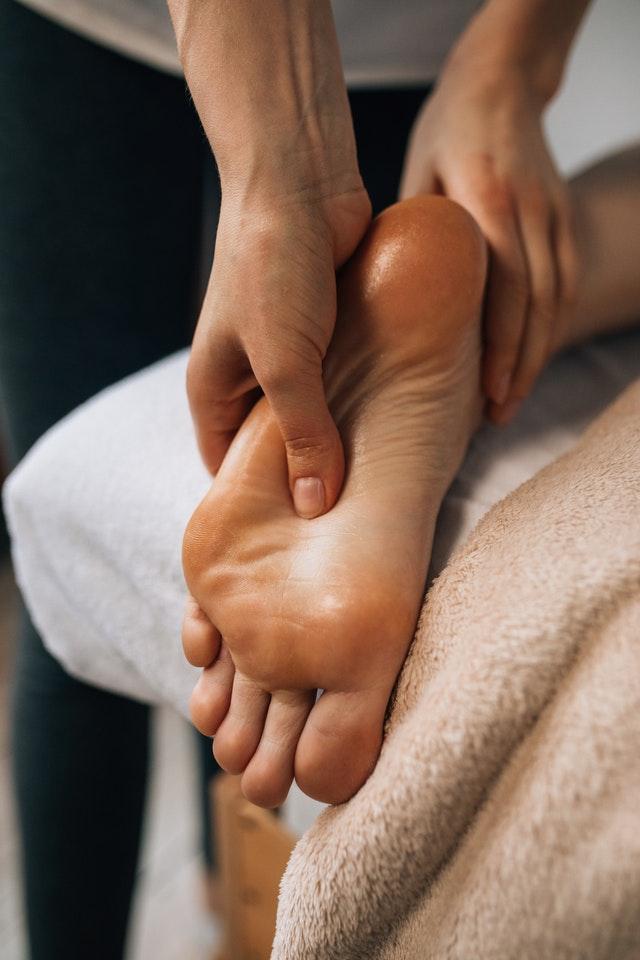
Peripheral neuropathy affects around 50% of persons that have type 2 diabetes. If you have type 2 diabetes, the nerves of your body’s extremities (feet and hands) are likely to be damaged by high blood glucose over time.
There is a variety of symptoms caused by damaged nerves ranging from mild to extremely debilitating. Further, the symptoms of diabetic neuropathy vary from one individual to the other. Some of the symptoms associated with diabetic neuropathy include:
- Cramps
- Diabetic foot pain
- Tingling
- Burning sensations
- Loss of feeling (numbness)
- Loss of balance
- Increased sensitivity to touch
If you are diagnosed with diabetic peripheral neuropathy, good foot care is essential for you. Good foot care is vital for you since it can likely help in the following:
- Slow down the progression of your nerve damage
- Reduce or get rid of the pain
- Prevent complications that may happen further such as infections, diabetic foot ulcers, and in the worst-case scenario, lower-limb amputations.
Diabetes reduces blood circulation in the feet.
You are at an increased risk for peripheral artery disease if you have diabetes. This is because a sticky plaque of fats and cholesterol builds up on the walls of your arteries.
The build-up on the walls of your arteries can slow down blow circulation drastically, and this can lead to the lack of delivery of oxygen and nutrients to your lower limbs and feet. You are at risk of increased foot infections, foot ulcers, and even foot gangrene with PAD.
Apart from preventing most complications caused by peripheral artery disease, diabetic foot care can also help boost blood circulation and decrease swollen feet.
Diabetic Foot Care Guidelines
Diabetes is harmful to your feet, and if you have it, poor diabetic foot care can result in having to amputate your toes, foot, or even your leg.
You might not notice an infection from a small cut or blister until it is too late. If you have either type 1 or 2 diabetes, you must adhere to a strict daily schedule at home to care for your feet. This is especially true if you have been identified as having peripheral artery disease or diabetic neuropathy.
Diabetes foot care guidelines that can help you prevent the most serious complications
1. Keep your HbA1c below 7%
Your blood sugar level has the utmost impact on the health of your feet. When you have diabetes, and it is not managed properly, and your blood glucose levels are not controlled, you are likely to have diabetes-related foot complications.
Therefore, if you want to stay away from foot problems, the first rule is to ensure that your HbA1c is kept below 7% and your blood sugars are in the range.
Following a healthy lifestyle, taking your medications, balancing your meals, exercising daily, and asking your doctor for advice regularly is the best way to keep your HbA1c below 7% and your blood sugars in range.
2. Get a diabetic foot exam once a year.
Medicare will pay for yearly foot tests for diabetic peripheral neuropathy patients. A podiatrist, your general practitioner, or another healthcare professional will perform a series of painless and risk-free medical tests.
Diabetes foot exams can identify issues that you might not be able to notice on your own.
It is advisable that you see your doctor immediately if you notice or feel any of the following apart from your yearly diabetic foot exam:
- If you have pain in your feet or legs
- Prickling sensations, burning or tingling
- Numbness or loss of sensation
- Should you notice any deformities on your toes or feet
- Loss of hair
- Cracks on your skin
- Any changes in your skin color
- When your toenails turn yellow
- Fungus infections
- Ingrown toenails, ulcers, sores, or blisters
You can considerably reduce the risk of foot problems and their aggravation through early diagnosis and prevention.
3. Inspect your feet daily
Diabetic neuropathy can lead to cuts and wounds staying unnoticed because of possible decreased sensation (numbness) in your feet.
Therefore, it is advisable that you inspect and check each side of your feet and toes on a daily basis. When inspecting your feet, you should check if your feet have redness, blisters, cuts, swelling, nail issues, bruises, calluses, and many more.
While inspecting your feet, it is also essential to check in between your toes and under your feet. You can use a mirror if you are physically unable to do so.
Additionally, if you have diabetes, you should never try to treat a foot problem by yourself. You should consult your doctor for advice if you notice anything unusual.
4. Gently wash and dry your feet.
If you want to avoid diabetes-related foot problems, then foot hygiene is a must. It would be best if you washed your feet daily in lukewarm water.
Using cold or too hot water is not advisable since it could do damage to your skin. While washing your feet, you should use a gentle foot wash or a mild soap. To dry your feet and between your toes, you should gently pat or blot your feet.
5. Wear shoes for diabetes & neuropathy
You can help prevent and alleviate the most common diabetic foot problems by donning diabetic shoes.
Diabetic shoes are different from regular shoes since they are medically and professionally designed for this purpose. These shoes are equipped with unique features that prevent and alleviate problems related to common diabetic feet.
The features include the protective inner linings that help in preventing your foot from blistering and irritating. Additionally, for improved foot stability and overall balance, diabetic shoes have enhanced foot support and extra-cushioning.
The shoes have a non-binding design which aids in the promotion of blood circulation to your foot. When it comes to neuropathy shoes, they are even more protective than diabetic shoes despite having almost similar features. Depending on your needs, you should consider having at least a pair.
Moreover, the pair of shoe fitting is essential. You should ensure that the diabetic shoes or neuropathy shoes are not too loose or too tight.
You can confirm this by inspecting the shoes before inserting them into your feet. Last, you should also ensure that there are no pebbles or foreign objects in the shoes that could harm your feet before wearing them. Too tight shoes with foreign objects or pebbles may lead to your diabetic feet getting swollen.
6. Consider socks for people with diabetes.
Socks are also essential in playing a role in diabetes foot care. You should change your socks on a daily basis if your feet sweat a lot to ensure your feet stay dry.
Additionally, the socks you wear should also be dry. If you have cold feet, especially at night when sleeping, it is recommended to wear socks to keep your feet warm. The socks also should not be too tight to compress your feet.
Diabetic socks have unique features. Some of the impressive features of diabetic socks include their soft elastic or no elastic at all. This will help in allowing blood flow to your feet by not constricting your leg and blocking blood flow.
These socks also will ensure that your feet stay in a dry, healthy environment thanks to the anti-bacterial fabrics used in making them.
The breathability of the socks will allow optimal airflow to your feet, while the moisture-wicking features in the socks will help in getting rid of any sweat and moisture hence leaving your diabetes feet dry and comfortable.
Furthermore, diabetic socks are designed to prevent blistering and irritations on your feet since they have extra padding for extra comfort and seamless construction.
7. Moisturize your feet
Your skin can be affected by dehydration caused by high blood sugars. The effects of dry skin include skin peeling, crackdown, or itch, which may cause further issues to your diabetic feet, such as foot ulcers and infections.
You should apply moisturizing lotion after washing your diabetic swollen feet every time after washing if you have dry skin on your feet. However, you should not apply moisturizing lotion between your toes since it may cause a fungal infection.
Further, there are moisturizers and foot care products of poor quality, and using them can be harmful to your diabetic feet.
Diabetic skins are fragile, and using poor quality products and moisturizers that contain chemicals can be too aggressive for your skin despite also not being efficient.
Therefore, it is advisable that you go for diabetic creams and lotions that have been carefully formulated. Only if you have dry skin should you use a moisturizer. If not, and your skin does not feel rough, you should wash and dry your feet each time after washing.
8. Keep your feet dry
Despite your feet needing to stay dry if you have diabetes foot issues, the skin of the feet should always stay moist. Dry feet are necessary with diabetic swollen feet since moist areas aid the development of fungal and bacterial infections. After being under the rain or snow, you should not let your feet stay wet for too long. If necessary, you should wear or use waterproof shoes.
You should choose appropriate socks and shoes with moisture-wicking and anti-bacterial fabrics if you tend to have swollen diabetic feet. It would be best if you changed your socks any time, they were wet.
9. Keep your feet warm.
People with diabetes tend to have cold feet because of poorer blood circulation. Generally, skin irritation, dryness, and foot problems are likely to increase due to cold.
Therefore, if you have diabetes feet, you should ensure that your feet are kept warm. However, they should not be too warm since too much warmth causes sweat.
It would be best if you chose socks with quality materials such as Merino wool, Alpaca fibre, or thick bamboo fibers during the winter and cold seasons to keep your feet warm. If needed, wear socks at night to keep your feet warm.
10. Trim your toenails properly
You may have foot issues such as ingrown toenails that can easily get infected if you trim your toenails badly. Additionally, at least once every week, you should inspect and clip your toenails.
- After taking a bath or shower, when your toenails are softer and more flexible, trim them.
- Make a straight cut across with a nail clipper. Avoid trimming the sides or rounding the corners.
- Avoid having your toenails cut too short. Leave around one millimeter of white showing at the tip of your nail.
- Never pull the cuticles back. They aid in preventing the entry of bacteria and infection into your nail matrix.
- To avoid jugged edges after clipping, smooth your nails with a nail file.
Can diabetics soak their feet?
You can help calm down neuropathy symptoms by soaking your feet in a basin filled with warm water or in a foot spa.
An excellent way to incorporate natural pain-relieving and soothing ingredients such as Epson salts, essential oils for neuropathy, medicinal herbs, or cannabidiol (CBD) products are to soak your feet in a basin of warm water or foot spa.
In conclusion, foot soaking is great, and it can help persons living with diabetic neuropathy foot pain. However, foot soaking is not a treatment for diabetic neuropathy.
Soaking your feet cannot repair damaged nerves but can relieve diabetic nerve pain. Any way to reverse diabetic peripheral neuropathy has not been found or proven scientifically up to date.
Therefore, soaking your feet in Epsom salts or apple cider vinegar has a well-appreciated pain-relieving effect you would be fond of, but it would not reverse neuropathy.
Foot soaks can help relieve nerve pain.
You can reduce nerve pain in your diabetic nerve pain feet by soaking them in warm water.
Additionally, while soaking and bathing your diabetes feet, you can take the opportunity to try some other home solutions for neuropathy.
You can do this by adding Epsom salts, medicinal herbs, or essential oils. You can be provided instant relief for neuropathic pain through warm water baths and foot soaks.
Warm water baths and foot soaks have proven to do the following:
- Relieve pain
- Reduce stress
- Relax muscles
- Increase blood circulation
Foot soak is no danger for persons with diabetes or neuropathy if used reasonably and wisely. However, you should be aware that your feet are fragile and prone to multiple conditions once your feet are affected by neuropathy and diabetes.
Therefore, to avoid injury, you should:
- The damaged nerves in your feet are not reliable enough for judging water temperature, and you could burn your skin without even noticing it. Therefore, you should always check the water temperature with a thermometer.
- Dry your feet but gently soak, particularly in the space between your toes. This is because you can easily get wounded and infected if you have wet skin blisters.
- Limit your soak time. More than 30 minutes of foot soaking time, three to four times per week, can weaken your skin’s barrier of defense.
- Take care when adding items to your foot bath. Some online foot soak recipes for neuropathy are too forceful and could harm you. It is advisable that you consult your doctor for advice first.




